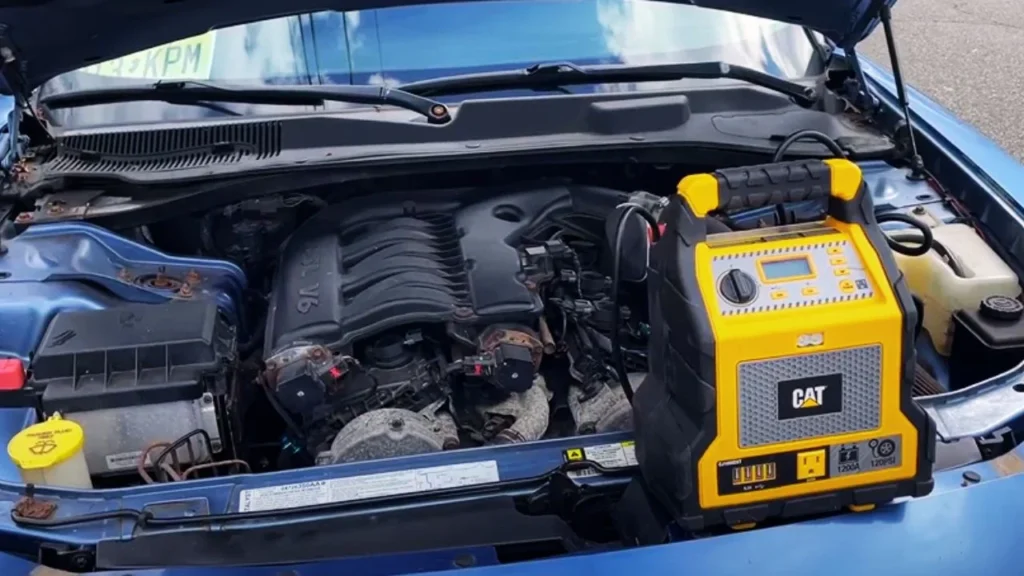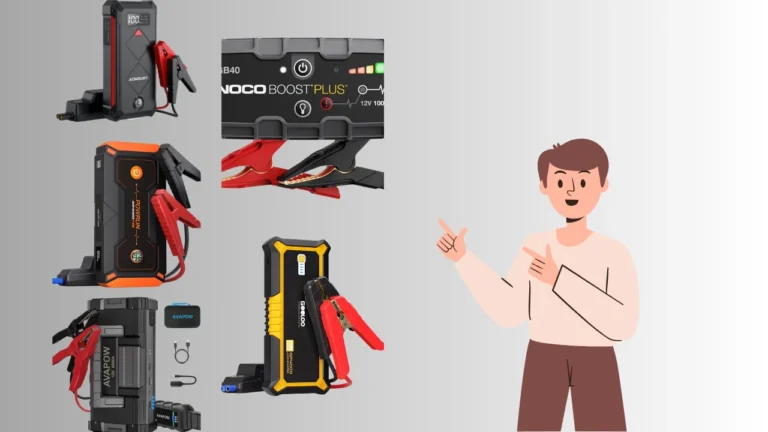Jump-starting a car is a common solution for reviving a dead battery, but the procedure comes with risks, particularly concerning the vehicle’s electronic systems. Modern cars contain complex computer systems—commonly called the Electronic Control Unit (ECU)—that are integral to managing engine performance, climate control, braking systems, and other functionalities. Does jump starting a car damage the computer?
Inappropriately jump-starting a car can potentially damage these systems, resulting in costly repairs. Discover practical advice on how to jumpstart a refrigerator compressor, a useful guide for when your fridge stops cooling properly.
Does Jump Starting a Car Damage the Computer?
So, does jump starting a car damage the computer? Yes it can. When jump-starting a car, there is a risk of generating a voltage spike that can damage the car’s electronic systems.
The alternator in the donor vehicle, which generates electricity to charge the battery and power electronics, can produce a high-voltage transient if not handled correctly. This voltage spike can affect the ECU and other sensitive electronics, leading to malfunctions and failures.
Following these steps minimizes the risk of damaging the car’s computer during a jump-start.
1. Voltage Spikes and Load Dump
One of the main ways jump-starting can damage the computer is through what is known as a load dump. This occurs when there is a sudden disconnection of the battery while the alternator is still providing charging current. The alternator responds by generating a voltage spike that can be harmful to electronic components.

Studies by the Society of Automotive Engineers (SAE) have shown that these spikes can range from 25V to 125V and last for 40ms to 400ms—enough to damage sensitive electronics like the ECU, powertrain computers, and other onboard modules if the surge protection mechanisms fail.
2. Improper Connection of Jumper Cables
Improperly connecting the jumper cables can lead to severe damage to the car’s computer. The correct sequence is crucial: the positive cable should be connected first, followed by the negative.

A common mistake is crossing the wires, which can result in a short circuit, causing the ECU and other electronic components to fry. Additionally, failing to use a proper grounding point when connecting the negative cable can cause overcharging or shorting of the battery, leading to further issues.
3. Running the Donor Vehicle During Connection
The risk of damaging the car’s computer increases significantly if the donor vehicle is running when the jumper cables are connected or disconnected. In this scenario, the voltage regulator in the donor car’s alternator can overcompensate for the load, resulting in a rapid voltage spike when the connection is made.

This spike can be strong enough to damage solid-state devices like the ECU, airbag systems, and other safety-related electronics in both the donor and the recipient vehicle. Explore whether it is bad to keep jump-starting your car battery, including the long-term effects it may have on your vehicle’s performance.
Components at Risk During a Jump Start
Several key components in a car can be damaged if jump-starting is not done correctly. These include:
- Electronic Control Unit (ECU): The car’s computer that manages engine functions, fuel injection, and other vital systems. A high-voltage spike can damage the ECU, leading to performance issues or a complete failure of the engine management system.
- Airbag System: Improper jump-starting may result in inconsistent electrical signals, which could cause airbag system failure. This is particularly dangerous as it might prevent airbags from deploying in an accident.
- Power Steering and Traction Control: The power steering system and traction control can also suffer due to inconsistencies in voltage during a jump-start, resulting in malfunction or reduced performance, making the car harder to control and less safe to drive.
Signs That Your Car Computer Has Been Damaged
If the ECU or other electronic components are damaged during a jump-start, there are several signs to look out for:
- Misfiring Engine: The car may begin to misfire due to incorrect fuel-to-air ratio adjustments by a damaged ECU.
- Increased Fuel Consumption: A damaged ECU may not correctly regulate the engine, leading to inefficient fuel use and higher fuel costs.
- Loss of Ignition Pulse: The ECU may fail to send the correct signals to the engine, leading to an inability to start the car.
- Electrical Burning Smell: If the computer’s internal components are damaged, you may notice a burning smell due to overheating of electronic parts.
Learn how to safely jump-start a box truck with this guide on jump-starting a box truck, covering essential tools and step-by-step instructions.
How to Safely Jump Start a Car Without Damaging the Computer
To avoid damage to your vehicle’s computer systems, follow these guidelines when jump-starting:
1. Use a Battery Jump Box
One of the safest ways to jump-start a vehicle is by using a battery jump box. This device provides a controlled and steady power source, reducing the risk of voltage spikes. A battery jump box can boost the dead battery to a safe voltage level without causing a sudden surge that could damage sensitive electronics.

2. Ensure Proper Cable Connection
When using jumper cables, always follow the correct procedure:

- Connect the positive cable to the positive terminal on both batteries first.
- Attach the negative cable to an unpainted metal surface on the car with the dead battery, away from the battery itself, to act as a ground.
- Never connect the negative cable directly to the negative terminal of the dead battery, as this increases the risk of a spark, potentially causing an explosion due to hydrogen gas.
3. Turn Off All Electronics
Ensure that both vehicles are turned off and the keys are removed from the ignition while connecting the jumper cables. All non-essential electrical accessories—such as lights, radio, and air conditioning—should be turned off to prevent any power surges that could damage the ECU.

4. Avoid Running the Donor Vehicle
Leave the donor vehicle off when connecting the jumper cables to prevent the alternator from generating a surge that could damage either vehicle’s electronics. Only start the donor vehicle after the connections have been properly made.

5. Check for Battery Condition
Before attempting a jump-start, inspect the dead battery for any signs of physical damage, such as cracks, leaks, or a foul smell. A damaged battery can produce unpredictable voltage levels, increasing the likelihood of damaging the ECU or other components. If the battery is damaged, it is better not to jump-start it.

Preventive Measures to Protect the ECU
- Use High-Quality Jumper Cables: Invest in jumper cables with built-in surge protection to help prevent voltage spikes during the jump-start process.
- Check Polarity: Double-check the correct polarity of the jumper leads to avoid connecting them incorrectly.
- Routine Battery Maintenance: Regularly inspect your car battery and clean any corrosion from the terminals to ensure a proper electrical connection, reducing the risk of needing frequent jump-starts.
Find out which portable car jump starter with air compressor is perfect for emergency roadside assistance.
What Happens If the ECU Is Damaged?
If the Electronic Control Unit (ECU) of a vehicle gets damaged during a jump-start, it can lead to various performance and safety issues. The ECU is essentially the car’s brain, and its main job is to control essential functions, including fuel injection, ignition timing, and the operation of auxiliary systems. A damaged ECU can lead to reduced fuel efficiency, increased emissions, and erratic engine performance.
Some of the specific consequences of a damaged ECU include:
1. Erratic Engine Performance:
The car may experience misfires, poor acceleration, or even stalling due to the ECU’s inability to properly regulate the air-fuel mixture. This happens because the ECU relies on input from various sensors to make decisions about engine operation. If it is damaged, it may fail to interpret sensor data correctly.
2. Safety Systems Failures:
A damaged ECU may also affect the airbag system, making it unreliable during an accident. This could prevent airbags from deploying, significantly increasing the risk of injury. Similarly, traction control and stability control systems may become compromised, affecting the vehicle’s handling and safety.
Explore the best portable marine battery jump starters for reliable performance when you’re out on the water.
3. Electrical Malfunctions:
If the ECU is damaged, other interconnected systems, such as power steering or anti-lock braking (ABS), may also be affected. This can lead to increased difficulty steering the vehicle or ineffective braking, making the car unsafe to drive.
Replacing or repairing an ECU can be quite costly, often ranging from $500 to $1,500 depending on the car model and the complexity of the system. Therefore, following proper procedures during a jump-start to avoid damaging the ECU can save you from significant expenses and ensure your vehicle remains safe to drive.
Conclusion
Jump-starting a car can indeed pose a risk to the vehicle’s computer and other sensitive electronic systems if not done correctly. The primary risks come from voltage spikes, incorrect cable connections, and running the donor vehicle during connection. These actions can lead to damage to the car’s ECU, airbag systems, power steering, and other electronics, resulting in costly repairs.
To safely jump-start a car, use a battery jump box, follow the correct connection sequence, and avoid running the donor vehicle during the process. By adhering to these safety precautions, you can minimize the risks associated with jump-starting and protect the vital electronics that keep your car running smoothly.
When in doubt, seek assistance from a professional mechanic to avoid damaging your vehicle. Hope so, now you know the answer to: Does jump starting a car damage the computer? Explore the best portable marine battery jump starters for reliable performance when you’re out on the water.
Ali is a tech enthusiast and automotive aficionado, passionate about sharing insights on the latest innovations and industry trends.





